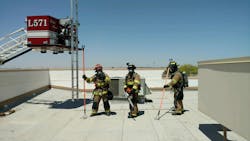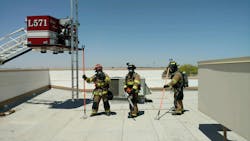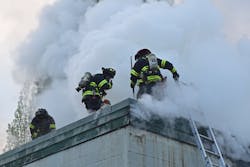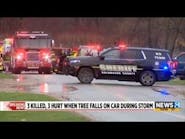Following the completion (or non-completion) of a vertical ventilation hole on a commercial building, a “good” roof report from the truck company officer to the incident commander (IC) may be the most important piece of information the IC uses to confirm or change the fireground game plan. As such, in this article, we will discuss how the roof report helps to drive the fireground strategy and what a complete report should include.
Critical vantage point
Too often the roof report does not provide the vital information that the IC needs to help with fireground decision-making, namely, planning their next assignment. Upon completion of a vertical ventilation hole, the truck company is in the best position to relay critical fireground factors by having observed basically the entire structure from the ground up and putting hands on the roof support system. Their report helps paint a picture that captures the whole structural package and provides the knowledge for the decisions that keep firefighters safe, both above and below the fire.
Interior crews can follow acronyms such as PCAN—position, condition, action and needs—when conveying sector/group reports, but it is my experience that roof reports lack any actual standard or common format. If the IC does not receive the correct information, it creates several problems:
- It ties up radio traffic while the IC asks for additional feedback;
- It shows that the truck company officer may not know exactly what fireground factors to look for in their report; and
- It does not describe critical and timely information that can influence task and tactical assignments.
Information-gathering
An experienced truck company officer will start a structural size-up in their mind en route to a fire by mentally picturing the structure to which they are dispatched and by listening to radio traffic as the on-scene report of fireground conditions are described.
Once on scene, they match perceived fireground conditions with actual circumstances.
Having received the order to vertically ventilate, the ladder truck should be spotted in a strategic position, preferably on an unburned corner and on the long portion of the strip mall or building. During deployment of ground ladders or an aerial for roof access, the company officer should observe fireground conditions. For example, they should consider building construction type from the exterior, noting whether it is tilt slab or block, an anchor store in a strip mall, as well as the fire load (type of occupancy), smoke conditions and parapet height.
During the time it takes to make roof access, the truck officer should use radio traffic and visual cues to confirm fire location (is it a room-and-contents or structural fire?) and predict its spread to confirm initial assumptions regarding ventilation hole location.
Accessing the roof
Depending on your department’s standard operating procedures (SOPs), some crews announce to the IC that they have made the roof, give a quick roof description, and confirm that they are continuing to the ventilation location.
Once on the roof, crews should make note of the type of roof covering, any smoke or fire showing through, and cut an inspection hole to open the roof to determine the design and direction of the truss support system. This step will also give crews the information needed to perform the proper sequence of cuts during the ventilation cut. The truss systems may include from lightweight, large dimensional wood, metal, cold rolled metal bar joists, or a combination. Knowing what you are standing on and then later observing the effects, if any, from fire in the attic will help paint that picture to the IC. Other factors to determine: Is there a firewall, roof load, and does the roof have good integrity? Use smoke-indicator holes cut into the roof en route to the ventilation location; these holes will help you continually monitor roof conditions behind you and use as a “bread crumb” trail to retrace steps.
The completion of the ventilation hole is the missing piece of the information puzzle. Once the roof is opened up, it allows the company officer to see what specifically is occurring in the attic and truss system underneath them as well as reflect conditions in the interior.Putting it all together
At this point the company officer has seen more aspects of the building and the effects of the fire than anyone else on the fireground. From the ground up, they have identified the type of building construction and evaluated fire conditions and heat-release rate based on what type of fuel is burning. They have also walked the roof top, visualizing it, and exposed the area and conditions underneath in the attic. They are able to process changes to the structure from different vantage points, evaluate the fire spread in the structure, and make real-time observations that influence decisions, including their own. All this intel allows for an accurate description of rooftop events and also confirms a go or no-go for interior fire attack operations.
Roof report
What comes next in the form of a roof report to the IC is critical, and there’s one word that can sway the strategy of the incident—that word is “fire.”
If the attic space is being consumed by fire, the support system and integrity of the roof is being dramatically compromised. The old adage, “If it is not safe to be above the fire, then it is probably not safe to be underneath,” applies here.
When the roof report includes fire, a quick check of interior conditions by the IC can confirm the need to reevaluate crew placement and how they are deployed within our risk management profile. If interior crews report there is “still” active fire burning in the attic after flowing water or the structural components are burning, not just room and contents, that could be a game-changer. The words, “we have fire above our heads” from a crew occurs in 81 percent of fireground maydays, according to Don Abbott’s Project Mayday study.
A complete roof report should include the following information:
· Acknowledge completion of the ventilation hole or the inability to safely complete the hole along with reasons why it was not completed (e.g., spongy roof, equipment failure or self-vented).
- What type of product is being emitted from the hole—is it heavy black smoke, light white smoke, wispy or pressurized?
- Is there active fire in the attic?
- What is the roof load and roof type; for example, are there A/C units, evaporative coolers, skylights or storage items, and is the roof flat or built-up?
- Roof integrity—is it strong or are there any sagging or spongy roof areas?
- Other factors, such as firewalls or hazards
- Announcement of the retreat off the roof, if applicable
- Report to command when back on the ground, followed with a personnel accountability report (PAR)
When you give your report, make sure that you have moved yourself and your crew to an area of the roof where you can deliver your message safely. Too many times company officers stay close to the ventilation hole, as they admire their work, and give the roof report from that position, which causes their crew to follow their lead and, consequently, you have a concentrated load in an area that is potentially getting weaker. A good report will not require additional questions from the IC, and allows the continuation of your exit off the roof. If at any point during the process of venting you determine that conditions warrant a retreat, it is paramount that the IC knows immediately—as well as the reason why you cannot continue with your task. A response from the IC will be completely different for a chainsaw malfunction than for fire showing through the roof.
One bit of advice for the company officer is to check with the crew prior to announcing that you are off the roof, and verify if they are available for reassignment, need to recycle SCBA bottles or need to enter rehab. Ladder work is never finished, and the IC may want to use your crew to address loss stopped efforts or other tasks. This states your crew’s physical condition and helps avoid guess work or follow-up questions the IC may have.
Following is an example of a good roof report: “Roof to command. Be advised we have cut a large ventilation hole in the Bravo/Charlie corner and have heavy pressurized black smoke emitting from the hole. This a flat built-up roof with a firewall to the Bravo side that appears to have stopped the fire spread in that direction. The roof has good integrity, and there are six industrial-sized air conditioning units and numerous vent hoods on the roof. We are exiting the roof with a PAR of four and will report when we are on the ground.”
As a side note, success comes from timing the cutting and opening of a ventilation hole with the interior application of water; otherwise, a significant amount of air is entrained. The closer the hole is above the fire, the better the results. That said, the vent hole should be selected on the ability to safely make the cut sequences and get off the roof.
As a former ladder captain, I know I would describe a roof report with a bit of a subjective suggestion. That would range from staying offensive (having a solid roof) to the need to go defensive immediately (fire showing through the roof). A good relationship built on trust and experience goes a long way into how much faith the IC puts into the roof report.
In sum
The company officer on the roof should be empowered with the ability to recommend an evacuation off an unsafe roof and thereby force the IC to match the reasons for retreat with interior conditions and make a strategic decision. On the other hand, confirmation of a stable roof and the capability of cutting a successful ventilation hole helps to confirm the tactical plan of the IC. Gaining the confidence to make critical calls on the roof come from information gathered in pre-fire planning, including walking roofs, training on vertical ventilation, and real-life experiences, to name a few.
Acting as the eyes for the IC and interior crews, and knowing how and what potential hazards to recognize on the roof, will increase the safety and the chance for a positive outcome for all personnel on the fireground.
Sidebar: Residential Roof Reports
The core of what makes a good commercial roof report is the same for a residential report—a sector/group officer wants to convey ventilation hole status/completion, product release, roof integrity, hazards, load and plans to retreat off the roof. There are differences in what tasks are performed by the truck company to put themselves in a position to open up a residential roof. Also, there is still an opportunity to use visual cues seen from the ground up to the vent location that will help to describe an accurate report to the IC.

Gibby Gorman
Gibby Gorman recently retired from his fire service career after nearly 33 years, which began in 1986 with the Tempe, AZ, Fire and Medical Department, where he served for 27 years. During that time, Gorman: worked as a downtown ladder captain for 14 years; responded on the SCUBA Rescue Team; worked on the hazmat team; served as coordinator for the Regional Technical Rescue Teams; taught fire science classes at the community college level; and presented ladder tactics for Firehouse World conferences,, including in 2020. In 2013, he became a battalion chief for the Maricopa, AZ, Fire and Medical Department. Gorman created Southwest Firefighting Concepts. He received his bachelor’s degree from Arizona State University.








